Advertisement
Planning on winning the "most baubled boat" prize this holiday season? Here's how to go about it safely.
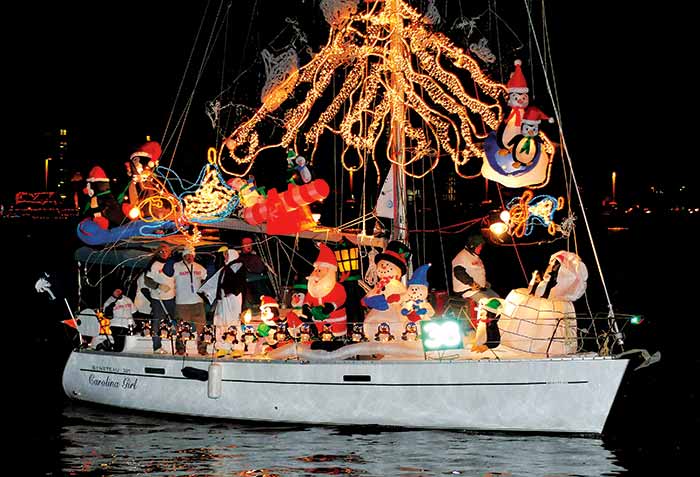
Photo: John Horm
Look at your boat and build on its strengths," says Pete Chambliss, Chief Elf (yes, really) of the Eastport Yacht Club Lights Parade in Annapolis, Maryland. While displays can be as simple as a strand of lights run along the toe rails, or as elaborate as Santa and the Abominable Snowman cage fighting on the bow while the elves look on, each one starts with a design. A powerboat is longer than it is tall, so it supports horizontal designs well. A sailboat works better with designs with some height.
Decide how you want onlookers to view the display. Inflatables on the foredeck can be viewed equally well from all sides of the boat, while words written in lights may be seen best from the port or starboard side. Now is the time to figure out what decorations to use, how to power them, and how to attach them securely to the boat. Outdoor-rated LED lights approved by Underwriters Laboratory (UL) last a long time, use little energy, and produce less heat, avoiding fire hazards. Many yard decorations can do double duty on a boat, too, because their size makes them easy to see and they're already graded for outdoor use.
Keeping Santa Safe When Powering Up
Adding extra lights to a boat increases the risk of fire and electrical shock, so deciding how to power the display has important safety implications. Before hanging them on the boat, check the lights for frayed wires and loose bulb-base connections. Wrap plug connections tightly between strands with high-quality electrical tape, and don't overload circuits. The number of strands that can be connected together depends on the type of lights, size of the wiring in the set, and power source being used on the boat.
AC-powered lights can be plugged into an inverter running off a boat battery; you'll want to use LEDs to minimize the current draw. You can also power up using a properly installed marine genset (be sure to fuel up during the day), but don't use a portable generator. Not only is there a risk of carbon-monoxide poisoning with a portable, they could tip over if you get hit by a wake and the hot exhaust could cause burns or start fires. If using AC power, make sure to use a pigtail with a ground-fault circuit interrupter (GFCI) as close to the source as possible. This will shut the power down if anything goes wrong in the circuit. AA battery-operated lights and 12-volt lights plugged into a 12-volt outlet are other options. If 12-volt outlets are used, the wiring and outlets must be protected by fuses or breakers properly sized to protect the wires supplying power to the outlet from carrying more current than they can safely handle. Any wiring connections should be clean and free from corrosion.
Tip
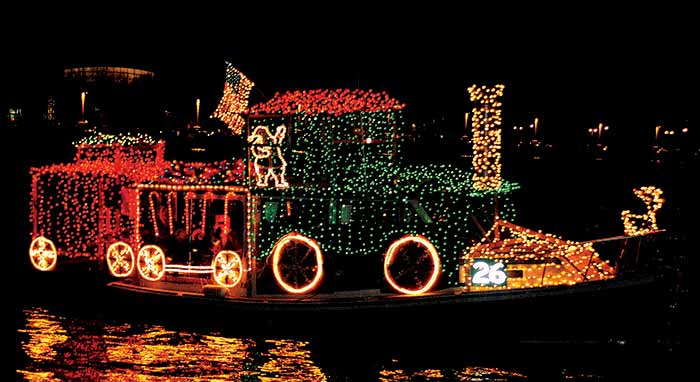
If you're 50, you need twice as much light to see as well as you did when you were 30. If your eyes are tired their ability to distinguish green from red will have deteriorated further. (Photo: John Horm)
Getting It All Up There
Attaching decorations when you don't have walls to tack things to is tricky. A simple method involves attaching lights with wire ties or duct tape. To make words or pictures from lights, use chicken wire. String the lights to the wire, and then staple it to wood frames, which are then secured to the boat using halyards, lines, blocks, and integral boat structures such as outriggers, masts, booms, and spinnaker poles.
String lights above the deck level, inside boat lifelines, in case docking or assistance is needed. Keep connections between strands close to the deck for easy access but high enough that seawater from waves or wake can't reach them. Make sure to keep connections away from metal rigging and metal support structures.
Be careful not to obscure your navigation lights. Don't decorate so bright lights fall within the skipper's line of sight, as that will destroy his or her night vision, and designate someone to stay out of the glare who can keep watch for obstructions and help navigate (see "How To Protect Your Night Vision").
Windarra's Design Has Got Legs!
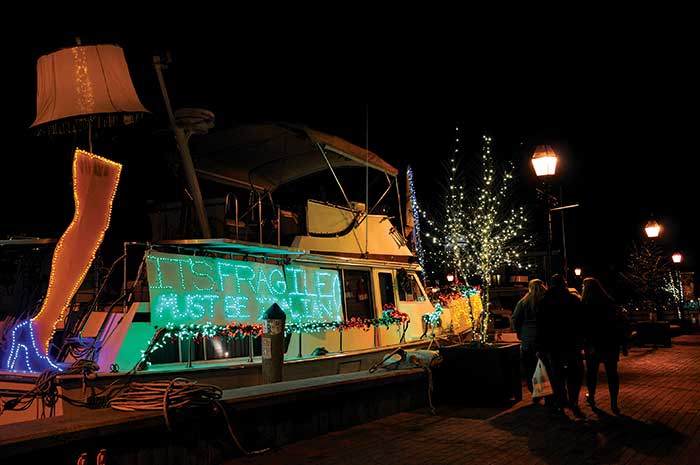
Photo: Rob Fettus
Rob and Julianne Fettus get many a chuckle with their homage to the movie "A Christmas Story" aboard their 43-foot Tollycraft Windarra. A well-lit eight-foot leg lamp, complete with shade, is mounted on their upper deck while their rails glitter with red and green lights and signboards flashing memorable phrases from the classic movie. Using plastic corrugated cardboard, the Fettuses created the lamp and signboards, which feature LED lights poked through the plastic like a Lite-Brite child's toy. The lampshade is hand-sewn, and the entire lamp is secured with guy wires at five attachment points. "Definitely test run in the evening while you're decorating," advises Julianne. "Walk away from the boat, and you'll be surprised at what you see. We're constantly jumping off during the test run, viewing from 50 feet away, and tweaking the decorations"
Don't Let Your Boat (Or Crew) Get Tied Up In Knots
Decorators should also consider how displays affect the boat's performance and overall stability, especially those using chicken-wire frames, because the extra weight of the structure can upset the balance of the boat. Hoisting a large chicken-wire frame is like hoisting a sail that can't be reefed or released. If the weather is too windy, or the frame too big, it can dangerously destabilize the boat. Keep in mind the crew will still need to get to docklines and cleats at the slip. Remember, crew will have to be able to move about and perform jobs, some perhaps on an emergency basis. Don't decorate in a way that interferes with safe boat operation. Double-check the weather forecast before leaving the dock so that you can ensure that your boat and your decorations will weather the elements well.
No Swan Song For Sally
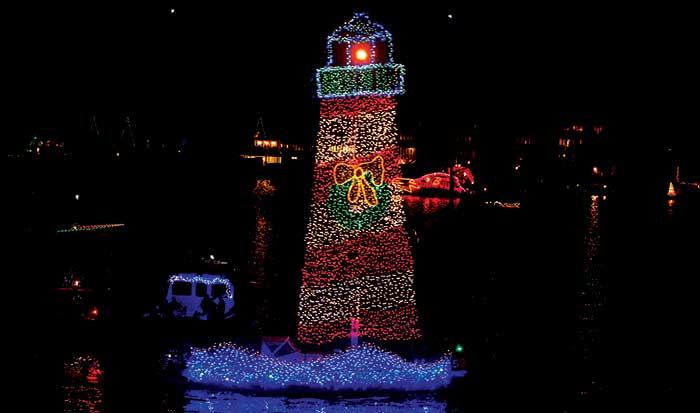
Photo: BrennanPhotos.com
John Yanik creates the award-winning lighthouse shining from his Swan 36 Sally by starting with a paper drawing that he transfers to three chicken-wire frames using a grid and spray paint. He then traces the borders of the lighthouse with twine and secures lights with wire ties between the twine borders. After testing the lights, he screws the frames together, hoists them with halyards and extra blocks, and secures the bottom frame to the boom. After several years of experimenting, Yanik says, "I've found limiting most of the design to two colors and stringing four lights per foot results in the greatest visibility." Looking at the photo, he gets no argument from us!
Float Your Art With Pride
Chief Elf Chambliss says that convincing first-time skippers to brave a cold December night on their boat can be a challenge, but once they start, they can't stop. "When you hear the roar of the crowd, it's so heartwarming that you forget the challenges and start talking about what to do next year. In many towns, it's the boaters' gift to the thousands of people who come out to watch the parade. Many people have told me that the Lights Parade is the start of their holiday season."
Molto Bene Does Well
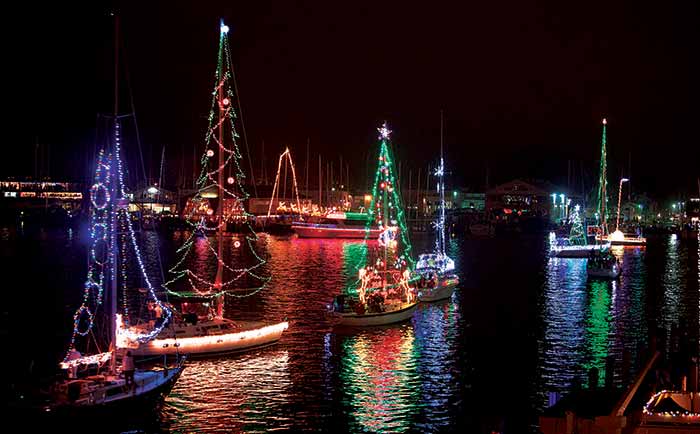
Photo: BrennanPhotos.com
For years, Richard Ewing and Idarae Prothero have delighted with the Christmas tree twinkling from their Beneteau First 42 Molto Bene. To make the tree, they run two temporary forestays and backstays from the deck to the top of the mast. Over the course of an afternoon, Prothero starts at the top of the mast, zigzags graceful arcs of green lights secured with wire ties between the stays, and connects the lights where the boom meets the mast. Strands of red lights act as garlands. "I don't string lights near the lifeline because they interfere with night vision, and I also like to plug lights into a power strip that's then plugged into a generator so I can turn on all the lights at once with a single switch."
Safety Tip: Use a GFCI-equipped pigtail between the power strip and the generator.
